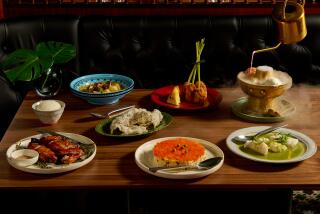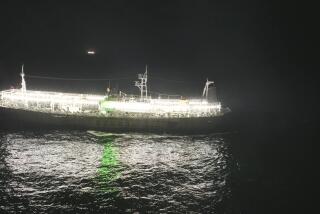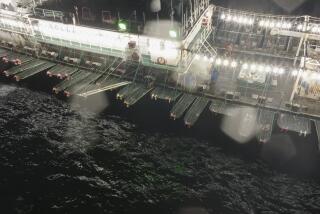Cruise: Southeast Asia : ASIA PORTS, THE LUXE WAY : Visiting Myanmar, Thailand, Malaysia and Singapore by small ship
ON THE ANDAMAN SEA â Southeast Asia, and the living is easy.
Along the shores of Thailand, Myanmar, Malaysia and Singapore, the jungle vegetation is in full riot, the old architecture is in picturesque post-colonial decline, modern economies are in overdrive, and here and there a beach lies fine-grained and underpopulated. Every day, I face a devil of a choice: explore ashore, or submit to serious luxuries aboard ship.
By serious luxuries, I do not mean the occasional complimentary umbrella-topped cocktail. I mean a perpetually open bar, a ban on tipping and the joy of pacing the well-scrubbed deck of a 409-foot-long vessel with fewer than 100 guest cabins. I could get used to this--but Iâd have to make the equivalent of my monthly mortgage payment every three days.
This is the good ship Song of Flower, possibly the premier vessel of possibly the worldâs premier luxury cruise line, Radisson Seven Seas. We have seven January days and nights at sea to cover 1,198 nautical miles and six ports of Yangon, Myanmar; Phuket, Thailand; Penang, Kuala Lumpur and Malacca, Malaysia, and Singapore. Some are grimy, some idyllic, some rustic, some relentlessly urban, all humid. Most of us have come principally because of these port calls, so we choose exploration over cabin sloth, at least by day. We shuffle through the incense-thick air of cool Buddhist temples, peer at the old-fashioned shop-houses of Malaysia, wander down dusty back streets in the former Rangoon. In bright and shiny Singapore, we listen as cabbies explain the black market in chewing gum. On the Thai island of Phuket, we either troop off to see kick boxing and elephants, or flop on the beach, lying in wait for a para-sailing session or an hourlong, open-air $10 massage.
At dayâs end, we retreat to our privileges. The crew of 144 serving about 150 passengers. The chateaubriand and caviar for the traditionalists, occasional Asian-spiced soups for those who dare. The video and printed-word libraries. The comfortable cabins, each with a VCR and mini-bar (again, no separate billing). And on the desk in each cabin, thereâs the telephone, from which one may call the United States by satellite, if one doesnât mind paying $15 per minute.
The Song of Flower is not a new ship. It entered service in 1986, was taken over and substantially upgraded by Japanese owners in 1987. Since 1990 it has been operated by Seven Seas, which in a 1995 merger became Radisson Seven Seas. The shipâs distinction is not so much its hardware, but its exotic itineraries and elaborate service.
When the shipâs tender brings us ashore for a beach landing at Phuket, an employee of the Kata Thani Resort stands waiting to rinse our feet, lest our enjoyment of the patio buffet be impaired by sand between our toes. When passenger Peggy Carr of Dallas one evening mentions in passing the shortage of chocolate desserts on the menu, head waiter David Jezequel secretly arranges the creation and delivery of a customized chocolate concoction to Carrâs room that night.
The bill for all this? Radisson Seven Seasâ most affordable price for my 11-night itinerary worked out to $4,585 per person, double occupancy. That figure, which included the cruise lineâs advance-booking discount, paid for the seven-night cruise, a weekâs shipboard eating and drinking, shore excursions, port fees, air fares from the United States, two pre-sailing nights at the high-end Shangri-La Hotel in Bangkok and two post-sailing nights at the Regent Hotel in Singapore. Stripping away non-cruising costs, the price of a Song of Flower cruise usually runs about $460 per day.
Thus, we are a ship full of retired attorneys, bank directors, stockbrokers, doctors, computer company founders and a few obvious inheritors who bear, in the words of one less-wealthy passenger, âthe scars of privilege.â The cruise lineâs vice president for marketing, Donna Remillard, estimates that the typical Song of Flower passenger has a household income of $150,000 or above, and is 60 or older. Most nights, the dress code is coat-and-tie for the men, and thereâs one formal night, on which tuxedos are preferred, dark suits tolerated.
At age 35, I am easily the youngest paying passenger. More than once, I am issued orders by other passengers who mistake me for the shipâs apprentice photographer. (Damn that ban on tipping.)
The only weak links are entertainment and lectures: One of the headliner acts, the Wright Brothers singing duet, leaves the ship early and mysteriously in Penang; guidebook author Carl Parkes, scheduled to give at least two slide-accompanied lectures on Southeast Asia, delivers one, then vanishes from the schedule, though he remains aboard.
On the brighter side--and in contrast to most cruises--there is no bingo, and there is no need to ever eat a meal with someone you donât find interesting: On a ship that accepts no more than 172 passengers, there are 172 seats in the dining room, with dinner service from 7 to 9:30 most nights, and tables for two, or four or six or eight or 10. Breakfast is in the dining room, or al fresco on desk, or in your room, whichever your prefer. To fill our evenings, we have a sure-fingered jazz quintet and an adept magician among our entertainers.
Our first port is Yangon, Myanmar, formerly Rangoon, Burma. There we circle the 300-foot-high golden spire of Shwedagon Pagoda, step among the throngs in the downtown marketplace, and prowl the rows of British-built buildings now decaying under the leadership of Myanmarâs repressive, isolationist State Law and Order Restoration Council, a.k.a. SLORC. Then, too soon, weâre gone. (In coming months, another article in these pages will look more closely at Yangon.)
*
On Jan. 21, between Yangon and Phuket, passenger George J. Connor celebrates his 83rd birthday, with considerable help from the shipâs crew, who know him well. Connor, a retired shopping-center magnate from Australia, has spent more than 160 days on the ship in the last year, following its itinerary wherever it leads.
At Phuket, Thailandâs glamour resort island, two of us commission a taxi for a quick mini-tour: a couple of scenic overlooks, a âsea gypsyâ camp where fishing families live in colorful squalor, a grove of rubber trees, a quick pass through the traffic-choked streets of Phuket Town. So far advanced is the tourism industry on this island that I could go bungee jumping next, or participate in a âpaint ballâ war at the shooting range (no Southeast Asian land battles for me, thank you), play golf, go horseback riding, go para-sailing . . . too many things. I go back to the beach, join a short snorkeling expedition, then settle in for a few hours of sitting and strolling on the beach.
On Penang there are nice beaches, too, but the architecture threatens to overwhelm the nature. The British established the island as their first settlement on the Malay Peninsula in 1786, and under their control, the city of George Town rose with a row of handsome mansions and a commercial district of hundreds of shop-houses with businesses downstairs and the proprietorsâ residences upstairs. These tile-roofed, two- and three-story buildings multiplied until they filled a teeming downtown grid, then settled into gradual decay while the Malaysians, independent since 1957, put up new skyscrapers and office buildings nearby. The cityâs population has now surpassed 400,000.
Walking through those colonial neighborhoods, itâs easy to be entranced by the succession of colorfully painted shade screens, the flower stalls, the Buddhist and Hindu temples, the mosques (most Malays are Muslim), the pungent smells of cooking in Little India, the chilly gusts from the air-conditioned rooms of jewelersâ row, the monosyllabic storefront signs of Chinatown. Once Iâm aboard a trishaw, however, the reverie doesnât last too long; seated in the hurtling, weaving two-passenger tricycle, youâre frequently six inches from being maimed by another vehicle.
For respite from the city, we head for the suburbs and the Penang Butterfly Farm, where I see many butterflies, discover the existence of water scorpions and horned rhino beetles (long enough to fill your shoe) in the Insects and Small Reptiles Display Room, and read the following legend on a display case.
Q: What happens to the human race if all insects decide to be active . . . all at the same time???
A: Three-fourths of all living things in this world are insects. If all of them were to be active at the same time they would create chaos and complete disruption to all human activities!!!
Chaos and complete disruption do not come next. But Kuala Lumpur does, and itâs not always easy to tell the difference. K.L., as the Malaysian capital is called, is in the middle of a rampage of growth. First we make the hourlong drive from Port Klang to the center of the city, then obligatory monument stops: the Independence square, a mosque, a museum. Around us rush 1.1 million K.L. residents. Above us rise the twin Petronas Towers, soon to become the tallest skyscrapers on the planet, now within months of completion. Chinatown is gridlocked with preparations for the Chinese New Year and the mosques are busy with observances of Ramadan. Set free for two hours, I discover almost nothing within walking distance but shopping malls and hotels. Just then, a young man with a portable telephone approaches.
âYou want young girl,â he prescribes. âUpstairs. Beautiful.â
Well, no. On the way back to the ship, I find that virtually all of my fellow travelers have enjoyed K.L.: They were wise enough take our downtown neighborhood for what it was--a bustling example of Westernization and economic development--rather than laboring to extract Asian local color, whatever that is.
This brings us to Malacca, and a strange bit of cruise-line spin-doctoring. The night before we go ashore, the shipâs matinee idol Norwegian captain, Dag Dvergastein, warns us not to expect much. After considerable input from passengers and crew, he says, the line will be dropping Malacca from next yearâs itineraries.
Because Malacca was once the trading capital of this peninsula, the Singapore of its day, most of us persist in our plans to go ashore. When the old quarter of town turns out to be a wee bit self-conscious (signs and pamphlets proclaim American Expressâ sponsorship of a downtown âHeritage Trailâ) and the âantique rowâ on Jalan Hang Jebat (a.k.a. Jonker Street) turns out to be mostly cheap trinkets and reproductions, we feel well briefed. And there are attributes to savor: the church and government buildings that date to the 16th century arrival of Portuguese traders, or the 17th century arrival and power grab by the Dutch, or the 19th century takeover by the British. Between landmarks, the narrow commercial streets are splashed with bright red New Yearâs decorations.
I linger longest on a lonely street one block off antique row, where a gate hangs ajar in front of what must have been a prosperous Chinese household or business. The roof is gone, and weeds are creeping up. Blue paint bleeds through on the flaking whitewashed walls, beams lie this way and that, weeds sprout from the floor, and mysterious symbols are etched above the doorways. The air is heavy with humidity. Given a choice between the American Express version of the Old World and this, Iâll take this every time.
Thereâs no postponing it. After seven nights of leisurely dinners and Jacuzzis at will, we draw up to the tidy, modern port of Singapore, and our unfailingly polite crew discreetly expels us.
Our consolation is two pleasant days and nights in Singapore. Strolls in the bright and shiny mall along Orchard Road. A quick drink in the utterly commercialized Raffles hotel, where Singapore Slings are mixed by the trayful and run $15 apiece. A ride on the spotless subway. A conversation, or two or three, with cabdrivers complaining about the heavy hand of the government. Then itâs time to dig out our return air tickets and fold away trinkets and memories from Yangon and Phuket, Penang and Malacca, Kuala Lumpur and Singapore.
Somewhere in the digging and folding, I come to a life decision: If all the worldâs insects should decide to become active at the same time, I want to be watching from a safe distance at sea. Possibly off the coast of Southeast Asia. Definitely aboard the Song of Flower.
(BEGIN TEXT OF INFOBOX / INFOGRAPHIC)
GUIDEBOOK: Smooth Sailing in Asia
The Song of Flower: Operated by Radison Seven Seas Cruises ([800] 477-7500), the ship has seven itineraries between Yangon and Singapore planned between now and April 1997. (The line has no childrenâs programs.) Embarkation dates for the seven-night cruises are Nov. 23 (Singapore-Yangon); Nov. 30 (Yangon-Singapore); Jan. 10, 1997 (Singapore-Yangon); Jan. 17, 1997 (Yangon-Singapore); Feb. 15, 1997 (Singapore-Yangon); Feb. 22, 1997 (Yangon-Singapore); March 30, 1997 (Singapore-Yangon). Beginning in January 1997, itineraries will add a second night in Yangon, dropping Malacca. Rates vary depending on guest cabin, embarkation date and advance purchase. (Between now and November, the shipâs itineraries include the Indian Ocean, the Red Sea, the Mediterranean, Scandinavia and the Baltic Sea.)
Among other cruise lines with ships in Southeast Asia in 1996:
Crystal Cruises (which sells only through travel agents; for brochures, call [800] 288-9883, ext. 101).
Noble Caledonia (a British Company represented by Esplanade Tours at [800] 426-5492).
Oceanic Cruises (a Japanese-operated line represented by Tourism Marketing Specialists in Los Angeles, [800] 545-5778).
P&O; Spice Island Cruises of Indonesia (a British company represented in North America by Boston-based Esplanade Tours at [800] 426-5492).
Princess Cruises (800) 421-1700.
Royal Caribbean Cruise Line (800) 327-6700.
Seabourn Cruise Line (800) 929-9595.
Silversea Cruises (800) 722-9955.
--C.R.
More to Read
Sign up for The Wild
Weâll help you find the best places to hike, bike and run, as well as the perfect silent spots for meditation and yoga.
You may occasionally receive promotional content from the Los Angeles Times.







